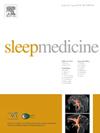Insomnia features and patient-reported daytime sleepiness in patients with obstructive sleep apnea
IF 3.8
2区 医学
Q1 CLINICAL NEUROLOGY
引用次数: 0
Abstract
Previous preliminary evidence suggests insomnia features playing a major causative or confounding role in daytime sleepiness in obstructive sleep apnea (OSA) patients. We investigated further this hypothesis in a larger OSA patient cohort. In a cross-sectional study in a tertiary medical center, consecutive patients presenting with suspected OSA, but without other sleepiness-promoting comorbidities, and tested by in-lab polysomnography (PSG) were evaluated prospectively for excessive daytime sleepiness (EDS) using the Epworth Sleepiness Scale (ESS) and for insomnia using the Insomnia Severity Index (ISI) respectively. Two hundred and thirty patients (63 female; average age: 54,1 y) were included in this OSA treatment-naïve cohort. ISI values correlated best (Spearman's rho = 0,29, p < .001) with the total ESS score than any PSG -associated metric did. Especially ISI item 7- (interference of sleep problems with daily functions, r = 0,33, p < .001) and item 2 - (difficulty staying asleep, r = 0,28, p < .001) and to a lesser degree item 4 - (satisfaction with own current sleep patterns, r = 0,23, p = 0,025) scores showed significant correlations. Notably, no single significant correlation was found between ESS score and any PSG-metric at all. In a multiple regression analysis, the ISI item 7 score emerged as the sole significant independent predictor of the ESS score. We conclude that insomnia may significantly impact patient-reported daytime sleepiness in OSA patients. We suggest that assessment of insomnia symptoms and features (e.g. by means of ISI) should always be performed in OSA patients reporting daytime sleepiness. We propose that these preliminary findings should be validated in larger and diverse cohorts of OSA patients.
阻塞性睡眠呼吸暂停患者的失眠特征和患者报告的日间嗜睡
先前的初步证据表明,失眠特征在阻塞性睡眠呼吸暂停(OSA)患者日间嗜睡中起着主要的致病或混杂作用。我们在更大的OSA患者队列中进一步研究了这一假设。在一项三级医疗中心的横断面研究中,连续出现疑似OSA但无其他促睡合并症的患者,并通过实验室多导睡眠图(PSG)进行测试,分别使用Epworth嗜睡量表(ESS)和失眠严重程度指数(ISI)前瞻性评估白天过度嗜睡(EDS)。230例患者(女性63例;平均年龄:54.1岁)被纳入OSA treatment-naïve队列。ISI值相关性最好(Spearman’s rho = 0,29, p <;.001),与任何PSG相关指标相比,ESS总得分更高。特别是ISI项目7-睡眠问题对日常功能的干扰,r = 0,33, p <;.001)和项目2 -(难以入睡,r = 0,28, p <;.001),在较小程度上,第4项(对自己当前睡眠模式的满意度,r = 0,23, p = 0,025)得分显示出显著的相关性。值得注意的是,ESS评分与任何psg指标之间没有发现单一的显著相关性。在多元回归分析中,ISI项目7得分成为ESS得分的唯一显著独立预测因子。我们得出结论,失眠可能显著影响OSA患者报告的日间嗜睡。我们建议对报告白天嗜睡的OSA患者进行失眠症状和特征评估(例如通过ISI)。我们建议这些初步发现应该在更大、更多样化的OSA患者队列中得到验证。
本文章由计算机程序翻译,如有差异,请以英文原文为准。
求助全文
约1分钟内获得全文
求助全文
来源期刊

Sleep medicine
医学-临床神经学
CiteScore
8.40
自引率
6.20%
发文量
1060
审稿时长
49 days
期刊介绍:
Sleep Medicine aims to be a journal no one involved in clinical sleep medicine can do without.
A journal primarily focussing on the human aspects of sleep, integrating the various disciplines that are involved in sleep medicine: neurology, clinical neurophysiology, internal medicine (particularly pulmonology and cardiology), psychology, psychiatry, sleep technology, pediatrics, neurosurgery, otorhinolaryngology, and dentistry.
The journal publishes the following types of articles: Reviews (also intended as a way to bridge the gap between basic sleep research and clinical relevance); Original Research Articles; Full-length articles; Brief communications; Controversies; Case reports; Letters to the Editor; Journal search and commentaries; Book reviews; Meeting announcements; Listing of relevant organisations plus web sites.
 求助内容:
求助内容: 应助结果提醒方式:
应助结果提醒方式:


